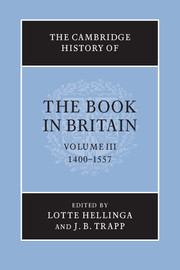Book contents
- Frontmatter
- Introduction
- 1 Literacy, books and readers
- TECHNIQUE AND TRADE
- COLLECTIONS AND OWNERSHIP
- 9 Private ownership of printed books
- 10 Monastic libraries: 1400–1557
- 11 The early royal collections and the Royal Library to 1461
- 12 The Royal Library from Edward IV to Henry VII
- 13 The Royal Library under Henry VIII
- READING AND USE OF BOOKS
- Appendix
- List of abbreviations
- Bibliography
- Photo credits
- General index
- Index of manuscripts
- Bibliographic index of printed books
- Plate Section"
- References
11 - The early royal collections and the Royal Library to 1461
from COLLECTIONS AND OWNERSHIP
Published online by Cambridge University Press: 28 March 2008
- Frontmatter
- Introduction
- 1 Literacy, books and readers
- TECHNIQUE AND TRADE
- COLLECTIONS AND OWNERSHIP
- 9 Private ownership of printed books
- 10 Monastic libraries: 1400–1557
- 11 The early royal collections and the Royal Library to 1461
- 12 The Royal Library from Edward IV to Henry VII
- 13 The Royal Library under Henry VIII
- READING AND USE OF BOOKS
- Appendix
- List of abbreviations
- Bibliography
- Photo credits
- General index
- Index of manuscripts
- Bibliographic index of printed books
- Plate Section"
- References
Summary
The Old Royal Collection is of respectable though not extreme antiquity. Its real founder was King Edward IV.
Edward IV (1461–83) is usually considered to be the ‘founder’ of the English royal library as it is known today. As the first King to leave a coherent collection of books – the large and expensive illuminated histories and chronicles in French, made for him and imported from Flanders – Edward IV has good claims to this title. Documentary evidence, however, suggests that the royal library in England had considerably earlier origins, although not a continuous existence. This chapter focuses on the Lancastrian period, the reigns of Henry IV (1399–1413), Henry V (1413–22) and Henry VI (1422–61), but to make sense of what took place after the deposition of Richard II in 1399, there needs to be a context. Accordingly some reference is made to earlier reigns. Much research remains to be undertaken, and caution is needed in interpreting the fragmentary evidence known to date. Sufficient materials have already come to light to draw some provisional conclusions about the royal library as a collection and about the places where it was kept.
The English documentary sources are notoriously difficult to assemble and to interpret. There are two main reasons. First, there are no formal inventories in England before the Tudor period, that is, there is no source comparable with the French and Burgundian inventories which allow us to know so much about the books, jewels, plate, textiles and other movables of the Valois kings and princes. A similar contrast could be drawn with the inventories of the Visconti, the Medici and the Aragonese kings of Naples. The French inventories include the 1380 general inventory of the goods of Charles V, which describes books dispersed among the various royal residences.
- Type
- Chapter
- Information
- The Cambridge History of the Book in Britain , pp. 255 - 266Publisher: Cambridge University PressPrint publication year: 1999
References
- 2
- Cited by

